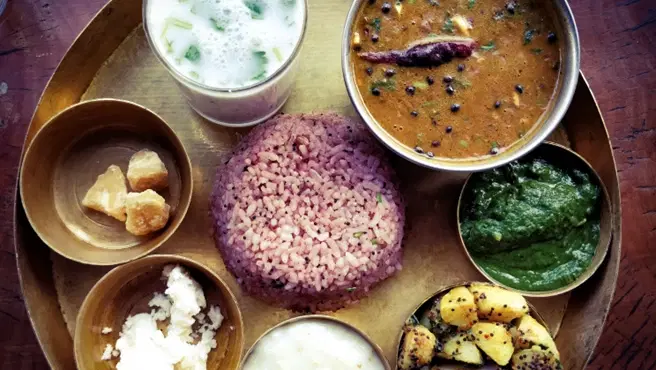
Flights
•04 min read

A steaming plate of rice and curry, with vibrant hues and rich aromas, invites you to savor an experience that's deeply woven into the fabric of Sri Lankan culture. This dish, celebrated as the national food of Sri Lanka, carries a legacy of tradition, spice, and heartwarming community gatherings. Planning your next journey? Book your flights with Air India or Air India Express on Tata Neu and earn NeuCoins (1 NeuCoin = 1₹ saving) for a seamless travel experience. In this blog, we answer frequently asked questions about Sri Lankan rice and curry, delving into its history, ingredients, variations, and the cultural traditions that make it so cherished.
Sri Lankan rice and curry evolved over generations, blending local traditions with the island's unique spices and flavors. With its roots in rich agricultural practices and the careful cultivation of spices like cinnamon, cardamom, and curry leaves, this dish tells the story of a culture where food and community come together in every meal.
This dish epitomizes the essence of Sri Lankan culinary heritage. From everyday family dinners to festive celebrations, rice and curry showcases versatility. It is not only a meal but also a symbol of togetherness and warmth, presenting an exquisite balance between simplicity and the sophisticated dance of flavors.
At its core, traditional Sri Lankan rice and curry is a celebration of fresh, local ingredients. A generous serving of rice is complemented by an array of curries—ranging from spicy fish ambul thiyal to hearty dhal curry—as well as sambols and other delightful accompaniments. According to traditional culinary guides, the judicious use of spices such as cinnamon, cardamom, mustard seeds, and curry leaves infuses each bite with signature Sri Lankan flavors.
The beauty of this cuisine lies in its diversity. Depending on regional practices and available ingredients, variations can include vegetarian options like eggplant moju and jackfruit curry or non-vegetarian delights such as chicken curry. These variations ensure that there is always a version of rice and curry perfectly suited to every palate, highlighting the inclusive nature of Sri Lankan culinary traditions.

In Sri Lanka, rice and curry is more than just a meal—it is a daily ritual that brings families and communities together. Whether shared during a simple lunch at home or as part of more elaborate festive celebrations, this dish embodies the spirit of togetherness and the importance of food in nurturing relationships.
The traditional way of enjoying this dish, often with hands, fosters a sense of closeness and connection. Eating rice and curry is an immersive experience where the tactile act of mixing flavors and textures adds a unique cultural significance, enhancing both the taste and the communal joy of dining.
Bringing authentic Sri Lankan flavors into your kitchen may seem challenging, but it starts with carefully selecting the right spices and ingredients. Look for freshly ground cinnamon, cardamom, and curry leaves to create that genuine aroma. A well-balanced curry is achieved by tempering mustard seeds and chili powder in coconut oil, a technique that elevates the flavor to a whole new level.
For those new to Sri Lankan cuisine, simple recipes such as dhal curry, chicken curry, or a zesty coconut sambol are excellent starting points. These dishes provide a glimpse into the depth of Sri Lankan culinary traditions and allow you to experiment with your own twist while enjoying the comforts of home-cooked meals. Planning a trip to explore these flavors firsthand? Tata Neu makes it easy to book your flights and earn NeuCoins, ensuring your culinary journey is as rewarding as your travel experience.
Did You Know? The Secret to Sri Lankan Curry Flavors
Sri Lankan curries are renowned for their unique depth of flavor, achieved by tempering spices like mustard seeds, curry leaves, and chili powder in coconut oil. This method not only enhances the aroma but also creates the signature taste that sets Sri Lankan cuisine apart.

Rice and curry is the most popular food in Sri Lanka, enjoyed by locals daily and revered as the national dish.
Traditional Sri Lankan dishes include rice and curry alongside other favorites like hoppers, string hoppers, kottu roti, and sambols, each reflecting the island's rich culinary heritage.
Not necessarily. Although spices are fundamental, the heat level can be tailored to suit individual taste preferences, ensuring a delightful balance between flavor and comfort.
The national fruit of Sri Lanka is the jackfruit, a versatile ingredient that also finds its way into traditional dishes like green jackfruit curry.
Absolutely. Many Sri Lankan rice and curry recipes celebrate vegetarian options such as dhal curry, jackfruit curry, and eggplant moju, making it accessible and appealing for all dietary preferences.
Rice and curry is much more than a meal; it is a cultural emblem that narrates the story of Sri Lanka through its rich history, traditions, and flavors. Every bite reflects the passion and artistry of Sri Lankan culinary traditions, making it a true testament to the island's gastronomic legacy. By mastering simple recipes at home, you can embark on a delightful culinary journey that connects you with the authentic taste of Sri Lanka. Beyond its delicious taste, each plate of rice and curry is a reminder of community, heritage, and the timeless art of sharing meals. Ready to explore Sri Lanka and its culinary wonders? Tata Neu helps you plan your travel seamlessly while earning rewards to make your journey unforgettable.